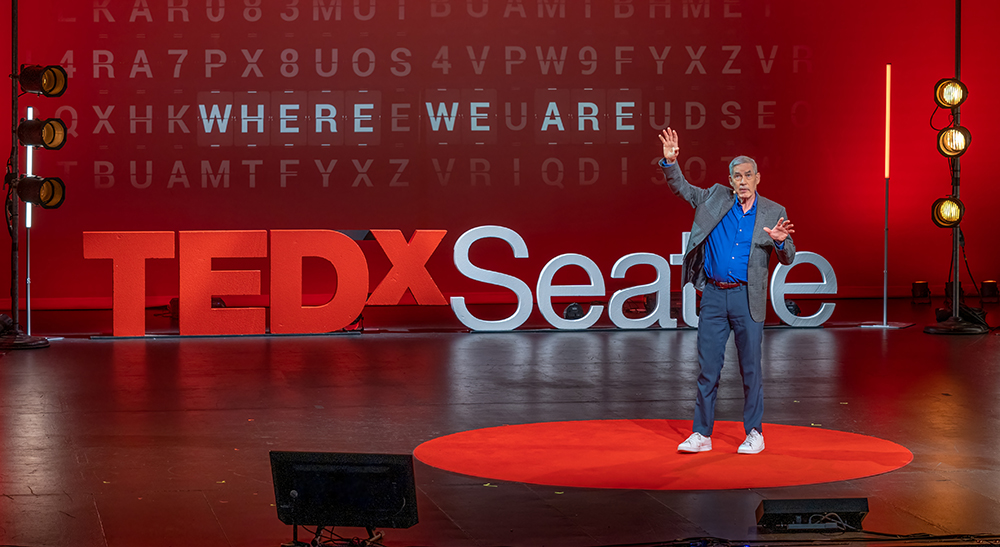Andrew Himes is CLF’s Director of Collective Impact. His 2021 TEDxSeattle talk is an impassioned plea for buildings that help solve climate change instead of contributing to it. With a sense of hope, Andrew asserts that working together to solve the climate crisis gives us the opportunity to “regain a sense of our shared humanity.”
As Andrew explains, the materials used in construction, the movement of those materials, and the current massive building boom combine to make the buildings in which we live and work one of the leading causes of carbon emissions. The good news is that we already know how to create buildings that store carbon and help heal the planet. We can reuse and improve buildings instead of tearing down or using new materials, and we can all demand that the buildings in our community are built to protect us instead of harm us.
More to explore
- Read about the Climate Pledge Arena mentioned in Andrew’s talk.
- Listen to Bill Gates discuss the innovations we need to avoid a climate disaster.
Meet Andrew Himes: advocate for social justice, co-founder of Microsoft Developer Network, and Director of Collective Impact at Carbon Leadership Forum. To tackle climate change, he wants us to dream big and embrace Goethe’s words: “Whatever you can do or dream you can, begin it.”
With his passion for addressing climate change and demand for social responsibility, Andrew asserts that where we are now is one of the most dangerous and promising moments in all of human history. Andrew says that many of us may feel that the issue of climate change is massive and global, and that there’s nothing we can do to make a difference.
But our built environment — the largest overall contributor to greenhouse gas emissions — can be either an existential threat or the source of transformative solutions to climate change. We can radically reduce carbon pollution and even store large amounts of carbon in buildings and infrastructure — permanently. But it will take millions of people demanding and creating solutions, working together in communities, simultaneously, toward one goal. We already have the innovative solutions we need. What happens next, he believes, is up to us.
Driven by his involvement in the civil rights and anti-war movements of the 1960s and 70s, Andrew believes the number one social justice issue in the world is the climate, because the people most harmed by climate change will be those most marginalized and most deeply disempowered.
After an accomplished career in tech (Himes was the founding editor of leading Apple technology journal MacTech and co-founder of the Microsoft Developer Network) Andrew was founding director for Charter for Compassion International, then created Carbon Innovations, a social impact consultancy focused on business-based solutions to climate change. In 2018, he was coordinator of Carbon Smart Building Day, a conference affiliated with the Global Climate Action Summit focused on transforming the global building industry to net-zero carbon emissions by 2050. His current role at UW involves leading industry-wide initiatives to reduce embodied carbon emissions in built environments.
This talk was given at a TEDx event using the TED conference format but independently organized by a local community.
“Buildings can enable us to partner with nature rather than oppose and exploit it — and screw it up. We can live and work in beautiful, healthy buildings made of materials created by natural processes like photosynthesis, the same magic that grows trees and flowers, vegetables and moss and lichen, and produces the oxygen we breathe in order to live.
“When you see a building being torn down, you should ask, is that demolition absolutely necessary? Was there no way to save and improve the building rather than trashing it? Those piles of debris, will they be recycled as part of a new building or just thrown away?
“And when you see any new building going up, you should ask, did anyone care enough to calculate how much carbon dioxide was emitted to make and transport that concrete, that steel, that glass, that timber, that insulation?
“We can use materials that help us thrive rather than materials that threaten to destroy our capacity to live on this planet.
“The natural role of buildings is to nurture and enhance our lives, not to threaten them. Buildings can protect us, teach us, comfort us, infuse our lives with beauty and community. Buildings can be life-giving rather than deadly. They can help us solve the challenge of climate change with elegance and innovation.”
